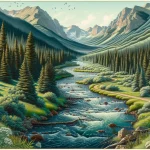Winding through the heart of Southern Colorado’s dramatic landscapes, the Highway of Legends Scenic and Historic Byway offers visitors a window into the region’s rich history, vibrant culture, and awe-inspiring natural beauty. Designated as a National Scenic Byway in 2021, this 82-mile route connects the towns of La Veta, Walsenburg, and Trinidad, passing through the lush Cuchara Valley, the lofty Sangre de Cristo Mountains, and the legendary Spanish Peaks.
In This Article
From exploring volcanic rock formations to hiking through old-growth forests, the opportunities for adventure and discovery along this national scenic byway are endless. Yet it is the legends and stories rooted in the land itself that truly bring the Highway of Legends to life. With tales of Spanish conquistadors, Native American myths, pioneer settlers, and even a mysterious beast or two, this scenic drive has no shortage of intrigue.
So buckle up and get ready to embark on a one-of-a-kind road trip experience through some of Colorado’s most captivating and historic terrain.
TL;DR
- The 82-mile Highway of Legends Scenic Byway connects La Veta, Walsenburg, and Trinidad in Southern Colorado
- Dramatic volcanic landscapes, lush valleys, forests, mountains, lakes, and more create diverse scenery
- History and legends of Native Americans, Spanish conquistadors, pioneers, and mythical beasts permeate the route
- Hiking, fishing, camping, rafting, and winter sports beckon outdoor adventurers
The Allure of Legends in the Landscape
What makes the Highway of Legends such a compelling journey is the way history, myth, and geology seem to converge in the landscape. The Spanish Peaks, for instance, are unmistakable landmarks, their stark volcanic forms jutting 7,000 feet above the valley floor. To the indigenous Ute and Apache tribes, these peaks were sacred ground, home to the gods and the source of magical deer and elk that could pass through solid rock. Spanish explorers in the 1800s named the peaks “Huajatollas,” drawn from the legends of two sisters who came to the mountains and never returned.
Every bend in this Colorado scenic byway reveals new surprises that stir the imagination – the massive dinosaur tracks preserved in stone near La Veta, the bubbling waters of Iron Springs just outside Cuchara, or the ancient volcanic plugs that the Ute Indians believed to be arrowheads fired down by the thunder gods. And for those who fancy a good legend, there’s always the monster rumored to inhabit the waters of Monument Lake…
So much of the Highway of Legends’ appeal lies in the thrill of not just observing these natural wonders, but stepping into the stories behind them.
Diverse Ecosystems and Wildlife
While legends may dominate this scenic historic byway’s identity, the reality of the diverse ecosystems and wildlife found here is just as compelling. As the road winds from mountain meadows to high desert, the landscapes transform dramatically. Travelers pass through two national forests, the Rio Grande and San Isabel, with detours to stunning waterfalls, wildflower-filled meadows, winding trails through old-growth forests, and panoramic overlooks. The national forests offer exceptional hiking, camping, fishing, and wildlife viewing.
The Highway of Legends also skirts several state parks and wildlife conservation areas. Birdwatchers rejoice at the John Martin Reservoir State Park and the Higel and Picketwire Canyonlands, with over 300 recorded species, including bald eagles and peregrine falcons. The Scenic Byway is a refuge for elk, mule deer, black bears, and mountain lions. Keep an eye out for the rare Mexican spotted owl or the endangered greenback cutthroat trout in hidden streams.
With this abundance of natural diversity, it’s easy to spend days immersed in the living legends of the land, watching wildlife, hunting for petrified wood, or simply breathing in the crisp mountain air.
From Ghost Towns to Gallery Towns
Beyond nature’s bounty, the Highway of Legends invites visitors to step back in time and explore history first-hand. The byway winds through numerous towns and villages frozen in the 19th century. Ghost towns like Rosemont, Gray Creek, and Weston Abandoned remind travelers of the region’s faded mining boom, while historic districts in Cuchara and La Veta offer charming glimpses into Colorado’s frontier settlements.
In the late 1800s, Walsenburg sprouted up around the first coal mines, ushering in immigrants from across Europe who shaped the town’s multicultural character. The Spanish-style architecture, murals depicting Walsenburg’s past, and museums like the Mining Museum and Lathrop State Park offer windows into this history. Meanwhile, Trinidad emerged as a supply hub and ranching center with Victorian buildings, brick streets, and its own historical attractions.
Art aficionados will delight in the Highway of Legends’ contemporary cultural revival as well. Dubbed Colorado’s “Gallery Town,” historic Trinidad offers a thriving arts scene. The town’s galleries, boutiques, cafes, and wine bars exhibit works by Georgia O’Keeffe and acclaimed Pueblo potters. La Veta, too, has emerged as an enclave for artists and creatives, with galleries, studios, culinary events, and art walks celebrating the town’s natural beauty.
From the long-abandoned ruins to the modern-day museums and galleries, the Highway of Legends gives travelers a living timeline of Southern Colorado’s past and present.
Scenic Wonders Along the Byway
For many road-trippers, the Highway of Legends’ spectacular scenery alone makes the drive worthwhile. The scenic highway climbs high into the Sangre de Cristo mountain range, past craggy peaks with names like “the Guardian,” “the Devil’s Stairsteps” and the “Spanish Peaks.” Snow-fed streams cascade through the San Isabel National Forest and flower-speckled meadows, inviting travelers to stop and daydream amidst the tranquility.
One highlight is the breathtaking Cuchara Pass, where the road switchbacks through a high mountain valley. Be sure to pause at the overlooks for views of the Cucharas River weaving for miles below. Just beyond lies the unique Dog Canyon suspension bridge. Other popular stops include Monument Lake, the Purgatoire River Canyon Overlook, and Iron Springs, where vibrant mineral pools bubble to the surface.
No matter the season, the Highway of Legends captivates with its natural splendor. Summer wildflowers launch fireworks of color across alpine tundra while autumn paints the hillsides in gold. Even in winter, the forests and peaks take on a quiet grandeur. For the planners, free downloadable smartphone apps like TravelStorys even offer guided audio tours to optimize the experience.
With so much majesty around each bend, travelers may just forget their final destination. The scenic wonders demand attention to imprint their image into memory and legend.
Hitting the Road – Byway Logistics
Now that we’ve glimpsed the legends, landscapes, and attractions of the Highway of Legends, it’s time to hit the road. Some logistics to keep in mind:
The route itself spans 82 miles along Colorado State Highway 12, connecting La Veta in the south to Trinidad in the north while passing through Walsenburg along the way. Most travelers begin their journey in La Veta and work their way north. With no major highways or interstates interrupting the peaceful countryside, expect a slower pace ideal for sightseeing.
While the byway could be driven in just 2-3 hours, several days allows time to fully immerse in the history, nature, and small towns along the way. Consider overnighting in “base camps” like La Veta, Cuchara, or Trinidad to break up the journey. Having a loose itinerary helps guide your exploration but leaving room for impromptu discoveries lets the legends lead the way.
The Highway of Legends Byway organization provides an excellent Corridor Management Plan outlining sites, available recreational activities, and trip planning resources. Whether traveling in an RV, motorcycle, bicycle or car, they offer tips to make the most of your road trip. Other handy resources include the Colorado Scenic and Historic Byways program, the Highway of Legends website, and published guidebooks like Gem Trails of Colorado.
When venturing off-road, be sure to pack appropriate gear, maps, and supplies. While cell service is available in most towns along the byway, coverage may be spotty in rural areas. Having offline maps and resources is wise.
However you embark on this scenic adventure, the Highway of Legends promises no shortage of mesmerizing sights, intriguing tales, and new legends waiting around the next curve. Let the road beckon. Adventure awaits!
FAQ About Highway of Legends
What is the best time of year to visit the Highway of Legends Scenic and Historic Byway?
The byway offers stunning scenery year-round, but the peak season spans summer and fall when wildflowers bloom, autumn foliage emerges, and wildlife is active. Summer sees more crowds, while spring and fall offer moderate weather and fewer visitors. The byway remains open in winter but services are limited in small towns.
What types of outdoor recreation are available along the byway?
The forests, peaks, lakes and rivers around the Highway of Legends provide endless outdoor recreation. Top activities include hiking, fishing, boating, kayaking, whitewater rafting, horseback riding, camping, hunting, mountain biking, backpacking, rock climbing, ziplining, and winter sports like skiing, snowshoeing and snowmobiling.
Where can visitors access trailheads and recreation sites along the byway?
Many recreational sites and trailheads are located within the San Isabel and Rio Grande National Forests near Cuchara Pass, La Veta Pass, and in the Spanish Peaks Wilderness. Stop by ranger stations or consult park maps to find trailheads. Monument Lake, Painted Rock, and Lathrop State Park also offer excellent access.
What other attractions and activities appeal to families visiting the byway?
Families enjoy the scenic overlooks, hiking trails suited for all ages, historic downtowns in Cuchara, La Veta, and Trinidad, museums, pioneer and mining sites, restaurants, shopping, festivals, fishing, boating, and accessing parks and recreation areas. The Highway of Legends has activities for all interests.
What restaurants, cafes, or local cuisine are recommended along the byway?
Top picks include the Trading Post Cafe and Tavern in La Veta, the Dog Bar and Grill in Cuchara, and Danielson Cafe and Sweet Things in Trinidad. Be sure to try green chile dishes, Mexican fare, bison burgers, craft beers, wines, and the area’s famous sugar beet candy.
Where can visitors access additional trip-planning resources?
The Highway of Legends Scenic and Historic Byway website, the Colorado Scenic and Historic Byways program, National Forest Services, TravelStorys, and published guidebooks offer detailed maps, brochures, audio tours, recreation information, and itinerary planning resources.






